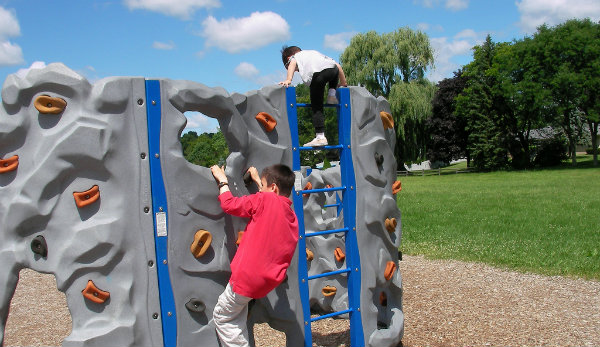
Recess for your Child with Special Needs: 7 Challenges and Solutions
If you ask a 6 year old child what the best thing at school is, the answer is usually “RECESS!”
Recess has major benefits for children’s well-being and ability to learn. According to the American Academy of Pediatrics, “Recess is a necessary break in the day for optimizing a child’s social, emotional, physical, and cognitive development...Peer interactions during recess are a unique complement to the classroom. The lifelong skills acquired for communication, negotiation, cooperation, sharing, problem solving, and coping are not only foundations for healthy development but also fundamental measures of the school experience.”
Recess is Scary!
But sometimes recess is the most anxiety-provoking part of the school day: 15 to 30 minutes of unstructured play surrounded by noisy kids. There’s always one child who goes to the same swing every day, and swings alone, counting the minutes until it’s time to go back to class. That child is my son.
How could he not like recess? Here are 7 of the most common challenges of recess and some possible solutions to promote inclusion.
1. It’s too loud!
I volunteer at lunchtime, so I know that the noise level is deafening both indoors and outdoors. Although it is important to learn how to desensitize to the noise as a necessary life skill, there are also several accommodations to provide some relief:
is deafening both indoors and outdoors. Although it is important to learn how to desensitize to the noise as a necessary life skill, there are also several accommodations to provide some relief:
- Allow earplugs or headphones as needed
- Offer an alternate, quiet lunch room for highly sensitive students - my son ate lunch in a classroom with a few other students for one year before he transitioned to the main cafeteria
- Lunchtime social skills program once a week in a separate classroom
- Schedule parent volunteers to monitor different areas for more recess options
- Section off an outdoor area for quiet play - my son’s school has a “wild side” with a playground and sports field and a “quiet side” with a few swings and a grassy area
2. I don’t know what to do
Unstructured time is extremely stressful for my son. Our local elementary school has a lunchtime mileage club, where students can get a card stamped for each lap that they walk or run around the field’s perimeter. This activity provides a sense of accomplishment while enjoying the scenery and talking with friends.
Other students may benefit from a checklist of recess activities, with the activities rotating daily. Some activities for the checklist might include:
- Catch a grasshopper and set it free
- Count 5 birds in the sky

- Find 2 people who would like to play jump rope with you
- Climb to the top of the play structure and slide down
- Ask a friend to push you on the swing, then take a turn pushing your friend
- After recess, tell your teacher what your favorite activity was
3. I just want to be alone
This is my son’s constant refrain. With all of the sensory input and intellectual demands of school, the need for solitude must be respected. I tell my son that it’s OK to be alone sometimes, but sometimes he also needs to make the effort to learn how to be around people. I explain that both social time and alone time are like vitamins that balance us and help us stay healthy. His speech therapist encouraged him to spend half of recess playing a game with other students, and half of recess recharging his batteries with alone time.
4. I feel vulnerable or unsafe
A sense of vulnerability or a history of being bullied are possible reasons for a preference for solitude during recess. There are several approaches to resolve these feelings.
- Model self-advocacy so that the student can speak up for him or herself - teach appropriate words and actions for difficult situations
- Do a walk-through of the play area to make sure it is accessible, safe and in full view of supervising adults
- Teach conflict resolution and good sportsmanship to all students, and provide a “problem-solving bench,” advises school psychologist Dr. Kenneth Shore
- Positive Behavior Interventions and Support (PBIS) have been proven to reduce bullying and other negative behaviors while increasing supportive and responsible behaviors among students, so ask if your school has plans to implement some type of PBIS
- Peaceful Playgrounds offers online training in inclusive games and bullying prevention for playground supervisors. The website also sells stenciling kits for asphalt so that students have more options for playground games.
- Leader in Me is a character education curriculum that incorporates PBIS. Students learn how to become proactive and involved in their school community. Rapidly increasing in popularity, the main disadvantage of this curriculum is the cost - about $30,000 spread over 3 years for a school of 500 students to receive training and support.
- Upstander is an anti-bullying curriculum for high school students. Since most people are neither perpetrators nor victims in bullying, this curriculum approaches the topic from the perspective of the “bystanders,” who are in fact the majority of students. The bystanders are empowered to stop hurtful behaviors.
5. I like to do the same thing every day
Daily routines are wonderfully reassuring...until they are disrupted by circumstances out of our control. It’s important to vary the routine slightly to reduce dependency. It’s another situation when a menu or checklist of activities can be rotated during the week; a rotation of friends to play with may also be helpful to shake up the routine.
6. I don’t know who to play with
Peer-to-peer support can be written into a student’s IEP to provide companionship during recess. Programs such as Circle of Friends and LINK have demonstrated that peer-to-peer support is equally beneficial to the focus person and to the typically developing peer. Informally, I have also reviewed with my son the names of friendly students with whom he enjoys spending time, so that he always knows he doesn’t have to be alone.
7. I don’t know how to join in
Many students with and without special needs struggle with anxiety over joining a group that is already involved in some activity - the fear of rejection affects everyone at some point in time. Practicing a script ahead of time can help reduce that fear - identifying a group of welcoming peers is another step in the right direction.
My son’s fourth grade teacher went outside to facilitate recess interactions until her presence was no longer necessary. Inclusion must be actively taught and promoted, not taken for granted. Planning ahead can reduce everyone’s anxiety and make recess more fun.
Has recess been a challenge for you and your family? How did you resolve the problem?



